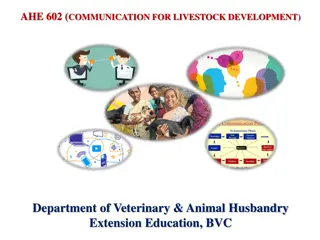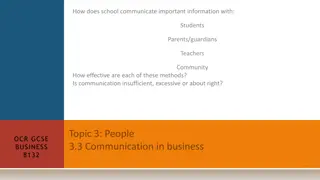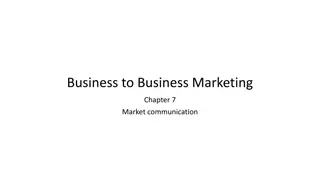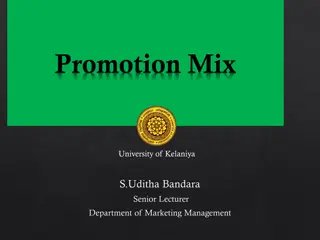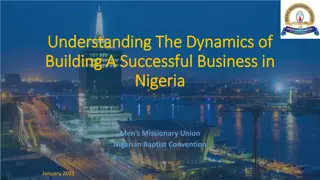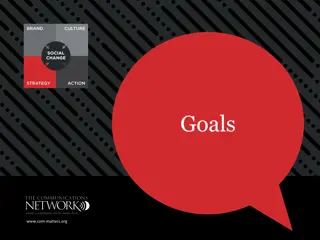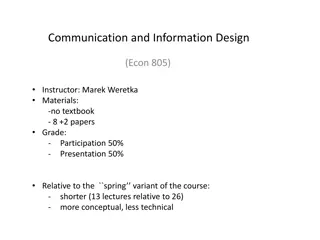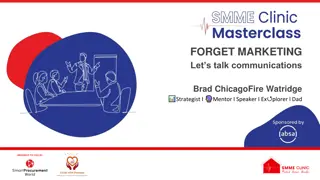Business Communication: Essential Concepts and Strategies for Success
Understanding the meaning of communication, various methods, media channels, types of business letters, and the layout of a business letter are crucial aspects in the field of business communication. Effective communication plays a vital role in achieving organizational goals and maintaining professional relationships. Explore the diverse elements of business communication to enhance your communication skills in the business world.
Download Presentation

Please find below an Image/Link to download the presentation.
The content on the website is provided AS IS for your information and personal use only. It may not be sold, licensed, or shared on other websites without obtaining consent from the author. Download presentation by click this link. If you encounter any issues during the download, it is possible that the publisher has removed the file from their server.
E N D
Presentation Transcript
PG & RESEARCH DEPARTMENT OF COMMERCE & BUSINESS ADMINISTRATION BUSINESS COMMUNICATION PADMAVANI ARTS AND SCIENCE COLLEGE FOR WOMEN,SALEM
Meaning of communication Communication is the process by which information transmitted between an individuals and organization. Communication is a skill to exchange messages, facts, ideas, opinion and to express emotions.
MEDIA Media channels for business communication include the Internet, print media, radio, television, ambient media, and word of mouth. Business communication can also be said to be the way employees, management and administration communicate in order to reach to their organizational goals.
Methods of communication methods of communication are; Verbal, Non-verbal, Written, Oral, Face to face. 5means of communication ar e; Internet, Radio, Newspaper, Telephone, Television.
Kinds of business letter Inquiry letter Offers and acceptance Orders and execution Credit and status enquiry letter Claims and adjustments letter Collection letter Circular letter Sales letter Banking correspondence Insurance correspondence Export and import correspondence Agency correspondence Secretarial correspondence Correspondence with the Government Public relation letter
Layout of a business letter Properly space the layout of the business letters you write, with space between the heading, the greeting, each paragraph, the closing, and your signature. ... Left justify your letter, so that your contact information, the date, the letter, and your signature are all aligned to the left.
Enquiries Letter of inquiry is a type of business message that asks the recipient for information or assistance. According to Gartside, An inquiry letter asks information like catalogue, quotation, sample and cost of a product form a seller in a concise and clear way.
Quotation A Quotation is a business offer made by a seller to an interested buyer to sell certain goods at specific prices and on certain terms and conditions. It is a reply by the seller to the prospective buyer. Hence, the quotation letter should be prepared carefully by the seller
Collection letters Letters written for realizing payments from the debtors are known as collection letters. The need for writing collection letters arises from credit sales. Selling on credit is a traditional business policy that enhances volume of sales.
Sales letter Sales Correspondence It is a letter that tries to sell a product. Sales letters are an effective way to communicate with clients. It may target a specific group to grab their attention. It is like a salesman discussing the purpose but in the form of a letter. A sales letter can be general or particular in nature.
Compliant letter The complaint may be so complex that a phone call may not effectively resolve the problem; or the writer may prefer the permanence, formality, and seriousness of a business letter. The essential rule in writing a complaint letter is to maintain your poise and diplomacy, no matter how justified your gripe is.
Circular letter circular letter is a kind of written announcement that is distributed to a large number of people to convey any commercial or non-commercial message at minimum time, costs and efforts. Drafting circular letter is purely an art.
Banking correspondence Correspondence with banks is essential for organizations. Banks also are business houses and they have to correspond with clients and customers. ... Banking correspondence is of a special nature because it deals with finance. Letters have to be carefully written to protect the interest of the bank as well as its clientele.
Insurance Insurance is a business that covers risks due to loss of life and assets due to fire, theft, burglary, natural calamities etc. ... Insurance correspondence demands tact, faith, courtesy and transparency in their content.
Life Insurance Life insurance (or life assurance, especially in the Commonwealth of Nations) is a contract between an insurance policy holder and an insurer or assurer, where the insurer promises to pay a designated beneficiary a sum of money (the benefit) in exchange for a premium, upon the death of an insured person
Fire Insurance The fire insurance contract is defined as an agreement, whereby one party in return for a consideration undertakes to indemnify the other party against financial loss which the latter may sustain by reason of certainly defined subject-matter being damaged or destroyed by fire or other defined perils up to an agreed .
Marine Insurance Marine insurance protects from business losses incurred during water transport operations. While policies vary, there are four standard types: hull, cargo, freight revenue, and negligence. Insureds may select all four types or use a cafeteria plan approach.
Agency correspondence Agency correspondence is the correspondence between the principal and the agent. The application for an agency, the appointment of an agency, its tenure and renewal, facilities provided by the agent, the support he receives from the principal, etc., form the subject matter of agency correspondence.
Company secretary The person who performs office correspondence of a company or supervises such activity is known as a company secretary. He is the in charge of dealing with directors, members, staff, Registrar of Companies and other government authority and institutions.
Agenda Agenda means things to be done. It is usually sent along with the notice of the meeting. It is a list of the topics to be discussed in a meeting. ... So, agenda is an items or issues prepared by the secretary and which are to be discussed or transacted in a forthcoming mitten.
Minutes Minutes is the official recording of the proceedings of the meetings and the decisions reached there in. minutes is a full but concise clear, lucid, true and accurate record of the business transacted at the meeting and the decisions and resolutions adopted there at .
Report Writing A report is an orderly and objective presentation of information that assists in decision making and problem solving. According to Betty and Kay, A report is a written or oral message presenting information that will help a decision maker to solve a business problem.
Types of Report Informational reports. These reports present facts about certain given activity in detail without any note or suggestions. ... Analytical reports. ... Research reports. ... Statutory reports. ... Non statutory reports. ... Routine reports. ... Special reports.
Structure of Report Title Page. Every business report should feature a title page. ... Summary. Most reports begin with a summary of the key points within, including: ... Table of Contents. ... Introduction. ... Methods and Findings. ... Conclusions and Recommendations. ... References. ... Appendices (If Applicable)
Job Application we can say that the letters that are written describing the personal data, qualifications, skills, and experience of a job seeker along with appeal for job is known as job application. This letter is generally written in response to the job advertisement of the employer.
Interview Generally, an interview means a private meeting between people when questions are asked and answered. ... So, an interview is formal meetings between two people (the interviewer and the interviewee) where questions are asked by the interviewer to obtain information, qualities, attitudes, wishes etc.
Types of interview One-on-one interview. ... Panel interview. ... Group interview. ... Lunch interview. The Telephone Interview. ... The Face-to-Face Interview. ... The Panel Interview. ... The Group Interview. ... The Sequential Interview. ... The Lunch / Dinner Interview. ... Competency Based Interviews. ... Formal / Informal Interviews.
Stages of Interview Interviews are typically broken down into these 5 stages of the interview process: Introductions. Small Talk. Information Gathering. Question/Answer. Wrapping Up.
Visual presentation Visual presentation refers to the expression of ideas about some matters while using visual aids such as visual multimedia. From electronic media such as television screens and web pages to environmental contexts such as retail displays and road signs, visual communication is virtually everywhere.
Group Discussion Group Discussion is an activity in which a group of individuals with similar interests communicate with each other for effective problem solving and decision making.






